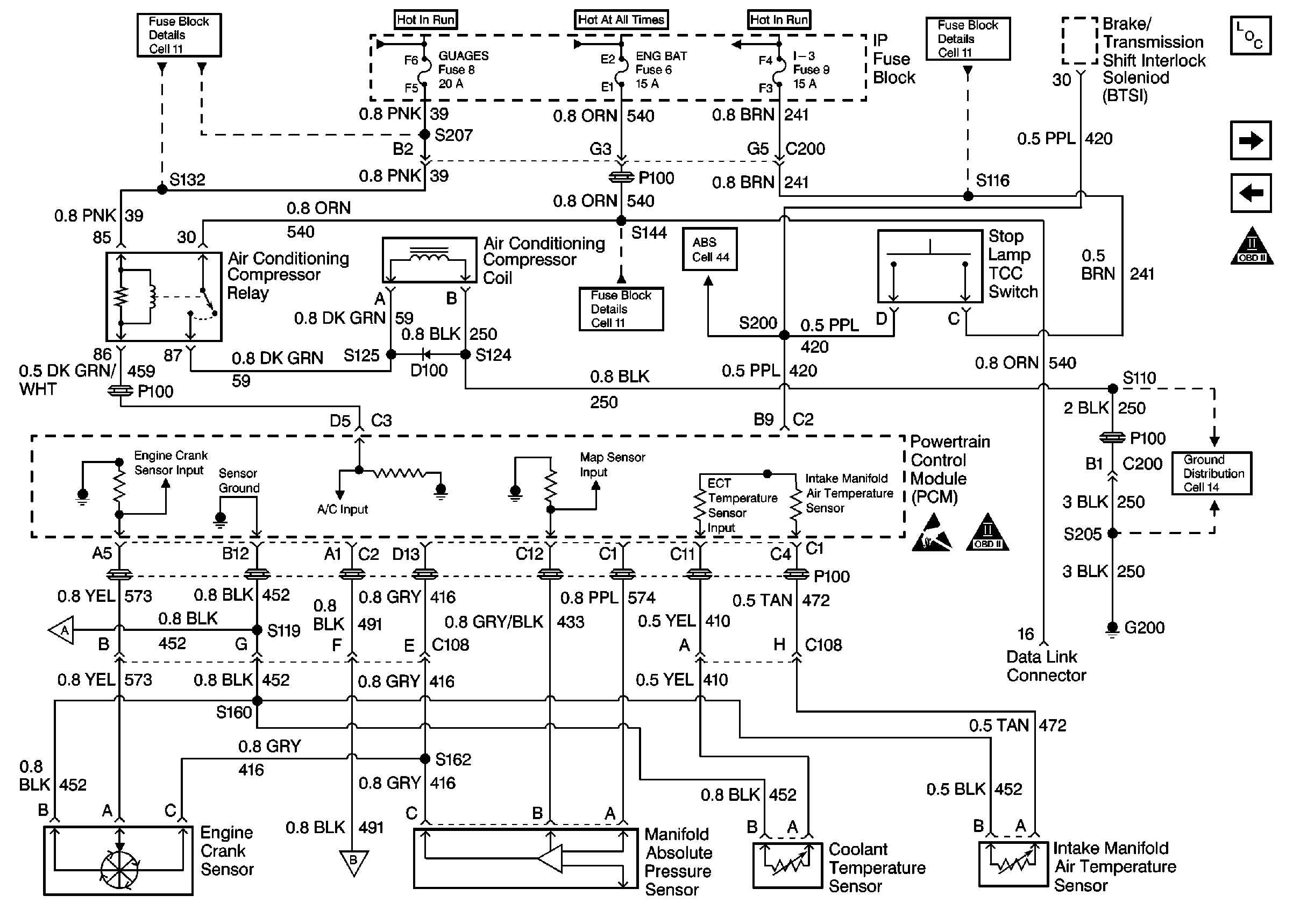Refer to
Cell 23: Sensors

Schematic
Circuit Description
The PCM uses the Baro sensor to monitor atmospheric pressure and then sends a signal back to the PCM. The PCM receives this signal and then calculates fuel delivery.
Conditions for Setting the DTC
| • | The PCM performs this DTC diagnostic continuously. |
| • | The Baro Pressure signal is less than 0.78 volts (40 kPa). |
| • | All diagnostic set conditions met for 2 seconds. |
Action Taken When the DTC Sets
| • | The PCM illuminates the Malfunction Indicator Lamp (MIL) on the second consecutive drive trip that the diagnostic runs and fails. |
| • | The PCM records the operating conditions at the time the diagnostic fails. The first time the diagnostic fails, the Failure Records will store this information. If the diagnostic reports a failure on the second consecutive drive trip, the Freeze Frame records the operating conditions at the time of failure and updates the Failure Records. |
Conditions for Clearing the MIL/DTC
| • | The PCM will turn the MIL off after three consecutive trips without a fault condition. |
| • | A History DTC will clear when forty consecutive warm-up cycles that the diagnostic does not fail (coolant temperature has risen 5°C (40°F) from start up coolant temperature and engine coolant temperature exceeds 71°C (160°F) that same ignition cycle. |
| • | Use of a Scan Tool |
Diagnostic Aids
A malfunctioning Baro sensor can cause excessive smoke at high altitudes.
An intermittent condition may be caused by the following:
| • | Poor connections. |
| • | A rubbed through wire insulation. |
| • | A broken wire inside of the insulation. |
Test Description
Number(s) below refer to the step number(s) on the Diagnostic Table.
-
This step will determine if DTC P0107 is the result of a hard failure or an intermittent condition.
-
This step simulates conditions for a DTC P0108. If the PCM recognizes the change, the PCM and signal circuit are OK.
-
In this step, components that share the 5 volt reference can cause the reference voltage to be shorted to ground. This can be checked by disconnecting each component that shares the 5 volt reference one at a time, including the PCM while checking for continuity on that circuit to chassis ground.
Step | Action | Value(s) | Yes | No | ||||
|---|---|---|---|---|---|---|---|---|
1 |
Important: Before clearing any DTCs, use the scan tool Capture Info function to save Freeze Frame and Failure records for reference. The control module's data is deleted once the Clear Info function is used. Did you perform the Powertrain On-Board Diagnostic (OBD) system check? | -- | ||||||
Does the scan tool display the Baro sensor less than or equal to the specified value? | 40 kPa | |||||||
Does the scan tool display the Baro sensor greater than or equal to the specified value? | 202 kPa | |||||||
4 |
Does the scan tool display the Baro sensor greater than or equal to the specified value? | 202 kPa | ||||||
5 | The DTC is intermittent. If no additional DTCs are stored, refer to Diagnostic Aids. If additional DTCs are stored, refer to those table(s) first. Are any additional DTCs stored? | -- | Go to the Applicable DTC Table | Go to Diagnostic Aids | ||||
6 |
Did you perform a repair? | -- | ||||||
7 |
Did you perform a repair? | -- | ||||||
8 |
Did you perform a repair? | -- | ||||||
Did you perform a repair? | -- | |||||||
10 | Replace the Baro sensor. Is the action complete? | -- | -- | |||||
11 |
Did you perform a repair? | -- | ||||||
12 | Replace the PCM. Important: The new PCM must be programmed. Refer to Powertrain Control Module Replacement/Programming . Is the action complete? | -- | -- | |||||
13 |
Does the scan tool indicate the diagnostic Passed? | -- | ||||||
14 | Does the scan tool display any additional undiagnosed DTCs? | -- | Go to the Applicable DTC Table | System OK |
